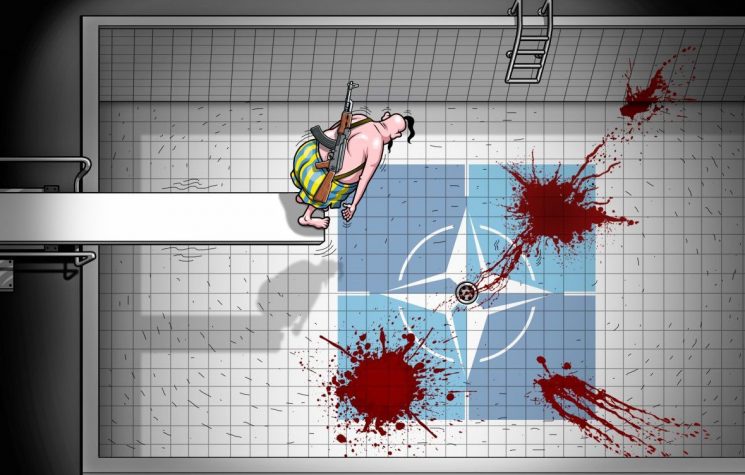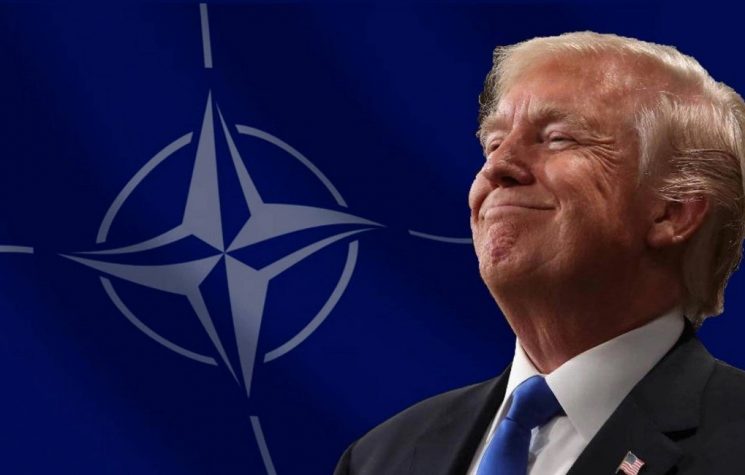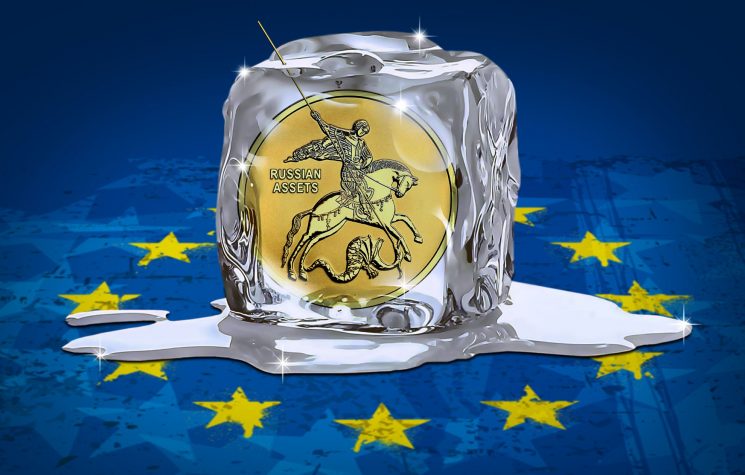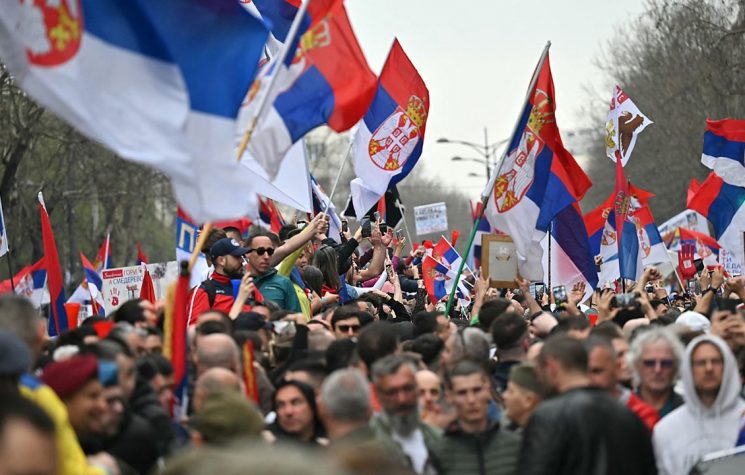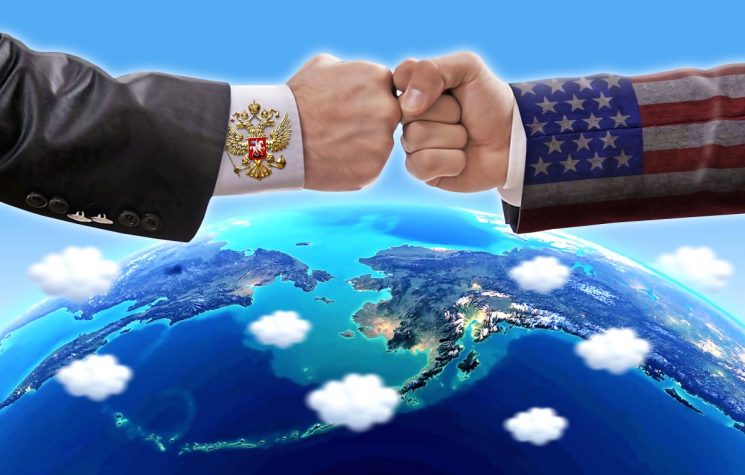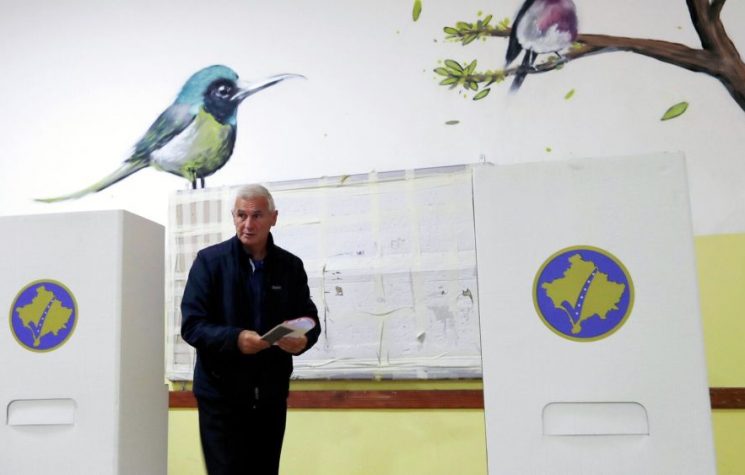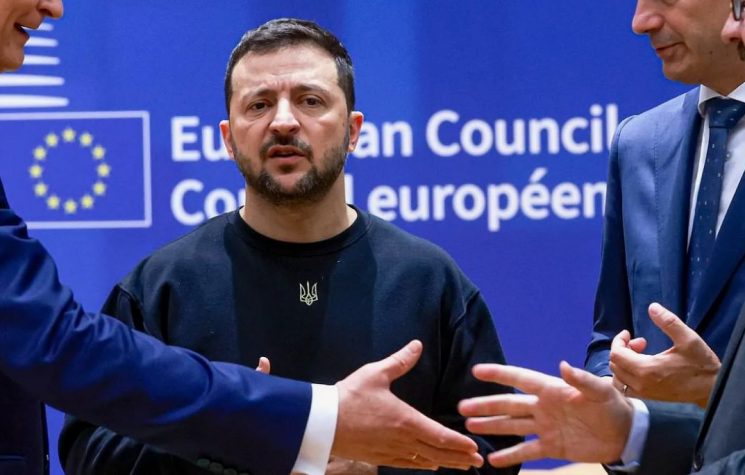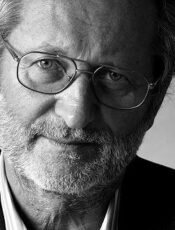The NATO edifice of lies, nurtured for decades, is more fragile than ever, Werner Rügemer writes.
After the 2nd World War in 1945 the USA knew: There is no danger from the weakened Soviet Union. But with the pincer grip of the Marshall Plan and NATO, the USA integrated the Western, Northern and Southern European countries into its economic and military expansion. Ex-Nazis and ex-Nazi collaborators were promoted, on the other hand anti-fascist parties, movements, persons were eliminated, infiltrated, bought. At the same time, the U.S. also helped the governments to fight against liberation movements in the colonies – also because of raw materials for US corporations. After 1990, the founding lie and thus the military-capitalist pincer grip was continued with the “eastward expansion”: Always first NATO membership, then EU membership. This includes the dismantling of prosperity and freedom for the majority populations: The EU and more and more US corporations, investors and consultants are organizing Americanization with working poor, working sick as well as legalized and illegal labor migration – at the same time militarization and hostility against Russia is being expanded: Domination of Eurasia from Lisbon to Vladivostok was the plan from the beginning.
We bring a chapter from the book by Werner Rügemer: Imperium EU – Labor Injustice, Crisis, New Resistances, tredition 2021. Of course, the war in Ukraine does not play a role in it yet, but it becomes explainable in some respects. Sources have been omitted.
“Russia” after World War 2: No danger
In the run-up to the founding of NATO, those responsible in the USA knew: The Soviet Union posed no military danger. The weakened power could not sustain an attack on Western Europe even if it wanted to: The Soviet Union’s economy is largely destroyed and technologically obsolete; its transportation system is too primitive; its oil industry is easy to attack. Nor does the Soviet Union have the atomic bomb. “The men in the Kremlin are clever tyrants who will not risk their internal power by military adventures abroad. They want to win the battle for Germany and Europe, but not by military action,” was the judgment of George Kennan, the chief planner in the State Department, for State Department chief Marshall, for President Truman, and for U.S. ambassadors in various memoranda in 1948.
But why did the U.S. and its then still few allies nonetheless establish NATO, a military alliance expressly directed against the Soviet Union?
The Legend of the “Cold War”
The legend states that NATO was a “product of the Cold War” after the end of World War 2. In reality, NATO is a product of U.S. expansion, which was already underway before U.S. military intervention in WWII.
The “cold war” is one of the most resourceful ideological constructs used by the U.S. opinion machine to disguise U.S. practices from WW2 to the present. The term was popularized by the most important US ideologue of the 20th century: Walter Lippmann, father of “neoliberalism.”
“Cold War” is supposed to mean: After WW2, the military war is over, and the phase of non-military confrontation between the “free West” and the “communist Eastern Bloc” begins. But during the “cold war” the USA and the first NATO countries waged hot, very hot wars, e.g. in Greece, Korea, the Philippines, in Africa and Indochina – this will have to be returned to.
In reality, the “cold” war began shortly after the war started, around 1941. Roosevelt and Churchill intervened militarily as late as possible in the war – despite repeated requests from their ally Stalin: The Red Army and the German Wehrmacht were to destroy each other as much as possible. The U.S. and British governments also rejected in principle to assist any internal resistance to Hitler. Wall Street lawyer Allen Dulles, as head of the intelligence agency Office of Stragic Services (OSS) based in Switzerland, did not want the assassins of July 20, 1944 to succeed – the U.S. military wanted to prevent an early armistice with the Soviet Union at all costs. The Red Army was to suffer as high losses as possible in the further fight against Hitler’s Wehrmacht.
Advancing the U.S. “defense” line to Europe
Walter Lippmann, a Harvard graduate who initially saw himself as a leftist and socialist, had helped organize the propaganda for the U.S. entry into the war for the U.S. War Department during World War I (Committee on Public Information, CPI): In 1917, the pacifist neutrality pledge of U.S. President Woodrow Wilson was to be reversed, and the U.S. entry into the war was now to be justified.
After that, Lippmann had theoretically justified and journalistically accompanied the global expansion of the USA in a prominent position – especially concerning Europe and Japan. In 1938, as an opponent of Roosevelt’s reform course (New Deal), he had brought together the later gurus of “neoliberal” economic theory such as Friedrich Hayek, Alexander Rüstow and Raymond Aron: It was here that the euphemistic term “neoliberalism” was coined for the global, anti-union, anti-communist sharpened doctrine of capitalism.
In March 1943, Lippmann wrote: After conquering North America, Central America, the Caribbean, the Philippines, and several islands in the Pacific (Wake, Guam, Hawai, Japanese Mandate Islands), the U.S. had been forced to “defend two-thirds of the earth’s surface from our continental base in North America.” Now, however, with the foreseeable defeat of the Axis powers of Germany, Japan, Italy, and their allies and collaborators, much broader access is opening up.
The U.S. will now no longer be able to “defend” its previously conquered territories, the geostrategist said, solely from its North American territory and scattered islands in the Pacific. Rather, America can and must now decisively expand its “defense” line “by basing our foreign policy on reliable alliances in the old world.” New U.S. bases could now be established in Europe and Japan. This would allow the U.S. to move from the previous passive to active “defense” of its national interests.
USA 1947: “War” Department becomes “Defense” Department
This strategy included ideological artifices: The anti-liberal and anti-democratic intensified capitalism doctrine was called “neoliberalism.”
And the intensified military expansion was passed off as “defense.” From 1789, since its founding, the U.S. factually had a War Department: through wars, the North American continent was integrated into the national territory, then Central America, the Caribbean, Cuba, then the Philippines, Puerto Rico, China, etc. were militarily penetrated, temporarily occupied, vassal governments were installed, islands – or parts of islands like Guantanamo in Cuba – were occupied and developed as permanent military bases.
But just at the highest stage of its also military expansion up to then, the War Department was euphemistically and factlessly renamed to Defense Department in 1947. That is why the aggressive NATO was called the “defense” alliance.
The Twin: Marshall Plan and NATO
NATO, founded in 1949, was the twin of the Marshall Plan. The dual military-civilian character was embodied by George Marshall himself: During World War 2, as Chief of Staff, he coordinated the U.S. military in all theaters of war between North Africa, Europe and Asia. After the war, as Secretary of State from 1947 to 1949, he organized the Marshall Plan. And in 1950, the agile man slipped into the role of U.S. secretary of defense, organizing brutal interventions, including napalm bombings, against liberation movements around the globe, in Korea as well as in Greece.
From 1947 on, all later founding members of NATO received aid from the Marshall Plan: Great Britain, France, Portugal, the Netherlands, Belgium, Luxembourg, Denmark, Iceland, Italy, Norway. This continued after NATO’s founding until the end of the Marshall Plan in 1952. In addition, in 1949, the U.S. Congress approved $1 billion in aid for the rearmament of NATO’s founding nations. In some cases, Marshall Plan aid was reallocated for military purposes.
All of these states – except Luxembourg, Italy and Norway – were also active colonial powers. Most of them were also monarchies and no paragon of democracy. The U.S. itself maintained numerous dependent territories around the globe in a neocolonial manner and dominated states in Central America and the Caribbean with the help of dictators – most famously in Cuba.
Preliminary Brussels Pact: “Germans” and “Communist Danger
Prior to NATO’s founding, the most reliable European countries slated to be founding members were allowed to make their prelude. In March 1948, the governments of Great Britain, France and the three small Benelux monarchies, highly subsidized by the Marshall Plan, adopted the “Brussels Pact.” It saw itself as a military alliance against renewed German aggression and against a threat of Soviet aggression.
These U.S.-led conspiracy practitioners simulated dangers that did not exist: Germany was fully disarmed and under military control of the Allies, including the Brussels Pact members themselves – France, Britain, Belgium, and the Netherlands were occupying powers in West Germany; and they could have a say in whether or not West Germany or the Federal Republic of Germany was rearmed. The Soviet Union was neither capable of nor willing to attack Western Europe, and even less willing to permanently occupy it – this assessment of the U.S. government was also familiar to the Brussels Pact states.
The Brussels Pact brought together, along with Great Britain, the states whose governments and economic elites had not resisted the occupation of the Wehrmacht, but had collaborated with Nazi Germany and also saw “communism” as the main danger. They all feared punishment, disentanglement or even expropriation after the war, the military and secret services feared loss of influence. But the U.S. held a protective hand over them.
On April 4, 1949 – a few months before the founding of the Federal Republic of Germany – the military alliance North Atlantic Treaty Organization, NATO, was founded in Washington. It was billed as a “defense” alliance, following U.S. language. All other members were dependent on the U.S., not only through the Marshall Plan, but also through additional loans, military aid and investments. NATO’s headquarters were in Washington until 1952.
Also there: Dictator Franco with special status
The ruling circles of the USA had admired Mussolini’s fascism: He had shown how to defeat the “communist danger” in the West. Mussolini was showered with loans by Wall Street, and U.S. investors bought shares in Italian companies, such as Fiat. With Mussolini and Hitler, U.S. corporations supplied the fascist Franco, who destroyed the Republic in a brutal civil war.
Franco had declared victory on April 1, 1939 – just two weeks later, the Roosevelt administration had appointed its ambassador in Madrid. Only Mussolini, Hitler, Pope Pius XII and the British fascist promoters King George VI with Prime Minister Neville Chamberlain had been quicker to diplomatically recognize the dictatorship.
For cosmetic reasons, Spain initially did not become a NATO member while Franco ruled. But the United States included Spain in its European expansion even without formal membership. They operated military bases here and promoted economic development, such as tourism. Fascism was compatible with “freedom and democracy” and NATO.
War against liberation movements in European colonies
With NATO, with additional U.S. military bases in NATO member states and additional partnerships such as with Spain, the U.S. not only pushed its “defense” line into Western Europe in Lippmann’s sense. It also supported the wars waged by the European colonial powers against the liberation movements in the colonies that had gained strength after the war. And in the process, the U.S. also gained access to raw materials in those colonies.
Great Britain
Britain had been supplied by the U.S. with armaments, ships and food during the war and was now heavily indebted to the U.S. The U.S. saw to it that the International Monetary Fund (IMF), which it had founded and controlled in 1944, made its first major loan to Britain in 1947: this was used to conciliate and blackmail the Labour government.
Britain was also weakened in other respects: its most important colonies, such as India, were lost. Already during the war, Great Britain had ceded several military bases in the Commonwealth to the USA (land lease program). At the time of NATO’s founding, the Labour-led government fought the liberation movement in Ghana, calling the leader of the Convention People’s Party, Kwane Nkrumah, a “little local Hitler” and putting him in prison in 1950. Only in 1957 was Ghana able to become independent with Nkrumah.
The U.S., which had already been present in Greece and Turkey from 1943 with its secret service OSS, replaced Britain’s military and secret service there in 1948 and took over the war against the anti-fascist liberation movement in Greece.
Canada
Canada, as a member of the Commonwealth, was doubly dependent: Since the late 19th century, the country had been an economic colony of the United States. Canadian troops and their intelligence service had been under British command, and British troops and the entire British war economy had been subordinate to the United States.
France
The second most important NATO member after Britain was France. The U.S. Army, along with the British and Canadians, had liberated the country from the Nazis and the Vichy collaborationist government under Marshal Pétain in 1944. The leftist Resistance, which had been infiltrated by the U.S. intelligence agency OSS, was gradually eliminated.
The unpopular General Charles de Gaulle, who had fought against Hitler and represented an independent France, had to be allowed to walk in the victory parade on the Champs Elysées in Paris, and then a provisional government was formed by him; it included the Communist Party, which had led the Resistance. But this government was never recognized by the United States. The World Bank, under President John McCloy, granted a loan to France even before the Marshall Plan, on the condition: De Gaulle and the Communists must be out of the government! U.S. Secretary of State Byrnes, Marshall’s predecessor, promised a 650 million loan and the additional delivery of 500,000 tons of coal.
Christian lacquered politicians like George Bidault, close friend of CDU chairman and future West German chancellor Konrad Adenauer and like the latter in contact with CIA chief Allen Dulles, were maneuvered into the government. De Gaulle was thrown out. The loan was granted. In 1948, the U.S. also rearmed three French divisions so that France could even act as a serious occupying power in its occupied territory in West Germany.
Algeria was not only a French colony, but was considered part of France, albeit with a racist apartheid system. This did not bother NATO at all: Algeria was immediately included in the NATO treaty area. The French government’s brutal colonial war intensified. By independence, the French military had killed hundreds of thousands of independence fighters and civilians.
At the same time, the French government demanded military aid against “communism” in the colony of Indochina: the Democratic Republic of Vietnam, proclaimed in September 1945 by the Viet Minh independence movement under Ho Chi Minh, was to be destroyed – the U.S. helped France with military advisors, food and armaments. McCloy, as president of the World Bank, also approved a loan for this purpose in 1949, the year NATO was founded.
Belgium, Netherlands, Luxembourg
The three Benelux countries had made no military contribution against Hitler’s Germany. Their governments and corporations had collaborated with the Nazis in the war. But Belgium and the Netherlands became NATO members and were allowed to enter West Germany as occupying forces by U.S. grace.
McCloy also conceded a World Bank loan to the Kingdom of the Netherlands in 1949, NATO’s founding year, so that the independence movement in the colony of Indonesia could be fought. Against the Republic of Indonesia, established in 1945 after the Japanese occupation, the 145,000 Dutch military forces proceeded to bomb cities, murder tens of thousands of resistance fighters and other locals, and capture the government.
Belgium
The Kingdom of Belgium continued to hold its resource-rich colony of Congo under the gun after 1945 with U.S. approval. The U.S. had obtained uranium, crucial for its atomic bombs, from the Belgian colony. The mining company Union Minière du Haut Katanga – in which the Rockefellers had a stake – had already moved its headquarters from Brussels to New York in 1939.
After 1945, anti-colonial resistance in the Congo was fought mercilessly: trade unions were banned, strikers were shot or publicly flogged. Later, in 1961, in Belgian-U.S. complicity (King Baudouin, U.S. President Eisenhower, CIA, native collaborators), the first prime minister of the newly independent Congo, Patrice Lumumba, was bestially murdered after a short time.
Portugal
Fascist Portugal had remained neutral in the war and therefore had been all the more important economically to Nazi Germany: As the most important state, Portugal supplied tungsten, a precious metal crucial to the war, for steel hardening, necessary, for example, for rifle barrels and cannon barrels. In Portugal, pirated shares and pirated gold were laundered to finance the German war effort.
After 1945, the USA returned the Asian colonies of Timor and Macau, which had been occupied by Japan, to Portugal. In the African colonies of Mozambique and Angola, colonialist forced and plantation economies (coffee, cotton) prevailed. The Communist Party, the main liberation organization, was banned and persecuted.
And the U.S. and NATO could now use Portugal’s Atlantic islands, the Azores, as military bases.
Small states and later NATO members
Iceland, a Danish colony, had been occupied by Britain and the United States in 1940. The country had declared independence to Denmark in 1944. Therefore, Iceland received Marshall Plan funds and agreed to its NATO membership. The small country maintained no military of its own, but served as a U.S. and NATO base.
Denmark: An anti-fascist government was formed here after the Nazi era. It included the Communist Party, which had resisted the Nazis. Here, too, the U.S., with the help of social democracy and the Marshall Plan, drove out the non-alignment originally intended.
In the Danish colony of Greenland, the USA had already established military bases in 1941. The Danish government, which had reserved foreign and security policy rule over Greenland, agreed: Greenland was declared a NATO defense area in 1951. The U.S. military base at Thule in Greenland was developed into one of the largest foreign U.S. bases as a forward espionage site against the Soviet Union and then against Russia, determining Danish foreign policy.
Norway: Here, the Social Democratic government wanted to remain non-aligned after the German occupation. But with the help of the Marshall Plan and additional rearmament aid, the U.S. maneuvered Norway into NATO.
Greece: In NATO’s founding year, U.S. dive-bombers napalmed the positions of the already victorious anti-fascist liberation movement in Greece and equipped the military loyal to the monarchy, which had collaborated with the Nazis. This was the only way to defeat the liberation movement. When the U.S. had ensured a U.S.-dependent government here as in neighboring Turkey, it brought the two countries into NATO in 1952.
Federal Republic of Germany: Largest U.S. Fortress in Europe
The U.S. wanted above all to bring the western occupied zones of Germany into NATO. But first, this West Germany was not yet a state; and second, the governments of France and Great Britain initially opposed rearming the Germans because of critical public opinion in both states.
But shortly after the founding of the new state of the Federal Republic of Germany (FRG), its Christian-painted chancellor Konrad Adenauer in 1950 agreed (secretly) to rearm. He had the peace and neutrality movements fought and incited as “communist”. The USA promoted arms production in the FRG for the needs of the war against the People’s Liberation Movement in Korea as early as 1950. The West German arms industrialists lobbied for NATO. And as early as September 1950, NATO included the FRG in the NATO defense area – five years before formally joining NATO.
Today in the 21st century, no other state on the planet hosts as many additional U.S. military bases – about 30 – as NATO member West Germany.
The USA invades the European colonies
NATO was thus an alliance against post-fascist and anti-fascist democratization in Europe and against national self-determination in the colonies. And the neo-colonial NATO leading state U.S. invaded the old colonies of the Europeans.
In the French colonies of Indochina (Vietnam, Laos, Cambodia) and Africa (a good dozen colonies, mainly of France, then also of Belgium and Portugal) important raw materials were stored. U.S. companies wanted to get their hands on them as cheaply as possible. Under Evan Just, the Marshall Plan authority in Paris maintained the “Strategic Raw Materials” department. It explored and inventoried in the colonies of the European colonial powers, for example, manganese and graphite in Madagascar; lead, cobalt and manganese in Morocco; cobalt, uranium and cadmium in the Congo; tin in Cameroon; chrome and nickel in New Caledonia; rubber in Indochina; oil in Indonesia; besides industrial diamonds, asbestos, beryllium, tantalite and colombit.
The Marshall Plan Authority and the State Department organized commodity purchase contracts beginning in 1948, for example, in favor of the U.S. corporations United Steel, Bethlehem Steel, and Newmont Mining. Investment banks such as Morgan Stanley and Lazard Frères formed joint holding companies to modernize mines in the colonies. For the atomic bombs, the U.S. needed even more uranium after the war than during the war anyway.
Finally, finally conquer Russia? Resistance!
For NATO, the founding was not about defeating “communism”, that was only a preliminary stage. It was and is about the U.S.-led conquest and exploitation of Europe, especially Russia, that is, all of Eurasia from Lisbon to Vladivostok (according to U.S. presidential adviser Zbigniew Brzezinski in 1996) and regardless of whether it is communist or capitalist.
NATO has been and continues to be an alliance that has principally and permanently violated the UN Charter, Article 1 “Self-Determination of Nations,” from its inception. NATO members – and also associate members such as Switzerland and Austria – joined in various ways in the numerous U.S.-led wars of the wrongly so-called “Cold War,” beginning with the Korean War and most recently, for example, for two decades in Afghanistan, leaving behind impoverished, devastated countries, with high profits for the arms, energy, supply and private military services industries.
And even under the otherwise somewhat criticized President Donald Trump, NATO’s European partners followed NATO’s leading power in anti-Russian agitation and rearmament to conquer the Eurasian theater, finally, finally succeeding, if need be again with war, and this time with nuclear bombs.
With the eastward enlargement of NATO the founding lie was continued. The EU membership of the ex-socialist states always followed a few years after the NATO membership. The EU continues to be an appendage of NATO. The relative economic support provided by the Marshall Plan brought only relative prosperity – and it was only a temporary concession. That ended in 1990. The EU, together with U.S. corporations, investors and consultants, has been dismantling relative prosperity ever since, step by step, first in Eastern Europe but, at the latest since the 2008 “financial crisis,” ever more rapidly in the “rich” states of Western Europe as well.
The stakes are high. The NATO edifice of lies, nurtured for decades, is more fragile than ever. Resistance to it must and can take on a new strength, on all continents. The legal-political basis are the original UN international law and UN human rights, which include labor and social rights. And that the military harms the environment more than others, even environmentalists can still learn.








